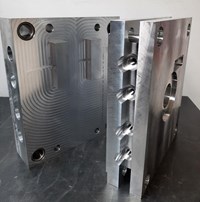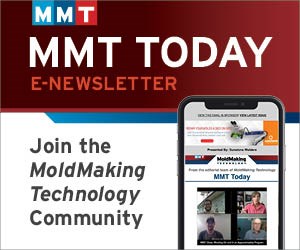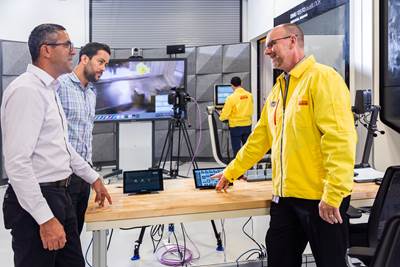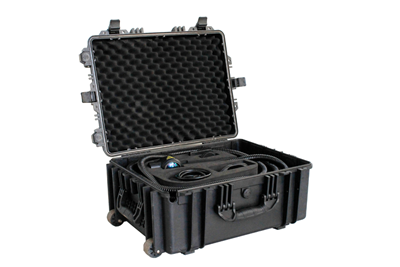Throwback Thursday: Rough Milling Applications: Technology and Tips
When it comes to productivity gains in rough milling applications, this article examines how cutting tool technologies and strategies can play a major role and how to measure and choose the right process and solution.
Part geometry, machine tool, programming and cutting tool are the major variables that each moldmaker deals with daily and which play a factor in the approach that each company takes when processing a mold. Regarding cutting tools for roughing, the approach and tool you choose may be unique for each job. Check out these rough milling application tips shared bby Iscar in this 2008 article:
Plunge Milling. Plunge milling has been around for a long time and can be the most consistent form of high metal removal, especially on older machines incapable of operating at high feedrates. This consistency is a result of efficient toolpaths, as there is little wasted tool motion when compared to more common methods of machining when part geometry forces the cutter into many directional changes (e.g., Z level).
Center cutting plungers exist, but the most recent advancements come in the form of side plungers. Programming solutions to support plunge milling is an area of recent improvements for many CAD/CAM companies, and good solutions exist for plunge milling of 3-D geometries, as well as 2-D.
On the product side, advanced pressing technologies have allowed the creation of inserts with more positive geometry, which reduces cutting and bending forces and allows plunging to be performed (for the most part) without the need for angular retracts. This saves time and intensive programming, allowing operators to use canned drilling cycles for plunging. Tangential designs provide increased strength with an insert having four edges for enhanced cost benefit.
Shred Milling. Anti-vibration milling cutters are a solution provider when vibrations and unfavorable conditions are encountered (long reach, unstable fixture, chip removal issues, machine power limitations). This technology is also nothing new, but it is an area that has been improved upon with positioning accuracy of the insert (to avoid feed overload from one tooth to the next) and a variety of insert (pressed and ground) geometries enabling the user to customize the tool to the application/material at hand. Usually, when faced with poor cutting conditions, the parameters are reduced to enable the completion of the part.
Other costly solutions include purchasing vibration dampening toolholders and coarse pitch cutters. With anti-vibration milling cutters, the wave design of the cutting edge creates small serrated chips, which are lighter and easier to evacuate from the cutting zone. The design also reduces cutting forces and breaks up harmonics (vibrations) that are common, especially in long reach applications.
High-Feed Milling. High-feed milling is the most universal approach to increased metal removal rates in roughing. High-feed type cutters have also been around now for quite some time, although many companies still have not experimented with the approach. For moldmaking, the high-feed approach in 3-D applications works very well because the small depth-of-cut characteristics leave small scallop heights (leftover material) for subsequent operations while maintaining a very high metal removal rate.
There has been a huge demand for cutting tools with high-feed geometry and this has led to the development of a wide range of tools, from solid carbide tools in smaller diameters (1/8" to 5/16") to the indexable tools ranging from 5/16" all the way up to 6” in diameter. This is also an area where advancements in pressing technology has enabled the creation of double-sided inserts that reduce cutting forces, while offering twice the number of cutting edges for enhanced cost savings (six edges per insert).
Read full article here.
Related Content
MMT Chats: 5 in 5 with Best Tool and Engineering
MoldMaking Technology Editorial Director Christina Fuges reveals 5 best practices for improving efficiencies within shops...in 5 minutes. Our guest is Joe Cherluck, President of Best Tool and Engineering in Clinton Township, Michigan.
Read MoreWhat Is Design for Manufacturing? Part 1 of 4
A DFM review ensures part design meets injection molding standards, enhancing cycle time, yield and aesthetics. Here are key considerations for the review.
Read MorePlay the Moldmaker Card Game at PTXPO 2025!
Think you’ve got what it takes to be a top moldmaker? Put your skills to the test with the Moldmaker Card Game. Dust off your decks from previous years or stop by PTXPO Booth 1235 to grab your own!
Read MoreWhat Is Scientific Maintenance? Part 2
Part two of this three-part series explains specific data that toolrooms must collect, analyze and use to truly advance to a scientific maintenance culture where you can measure real data and drive decisions.
Read MoreRead Next
How to Use Strategic Planning Tools, Data to Manage the Human Side of Business
Q&A with Marion Wells, MMT EAB member and founder of Human Asset Management.
Read MoreHow to Use Continuing Education to Remain Competitive in Moldmaking
Continued training helps moldmakers make tooling decisions and properly use the latest cutting tool to efficiently machine high-quality molds.
Read MoreReasons to Use Fiber Lasers for Mold Cleaning
Fiber lasers offer a simplicity, speed, control and portability, minimizing mold cleaning risks.
Read More






















